Introduction
This contribution looks at the former Soviet periphery to inquire how the postsocialist-postcolonial conjuncture is unfolding in the realm of infrastructures and social services. As part of a larger study on infrastructures and social mobilization 1, our research unpacks patterns of the underdevelopment and neglect of socially marginal communities and the latter’s attempts to compensate or challenge these state and municipal policy failures. We, thus, seek to examine these infrastructurally under- or non-developed communities as sites where regimes of capital accumulation and depreciation, the reshuffling of public-private ownership structures and the developmentalist aspirations of regional or global hegemonic actors produce distinct manifestations of the postsocialist-postcolonial conjuncture. Seen from this vantage point, forms of urban under- and de-development in the specific postsocialist Eurasian contexts can be conceived of as materialization of a wider global trajectory of neoliberal urban austerity and underdevelopment.
The contribution focuses empirically on ethnic minority-dominated districts in Plovdiv, Bulgaria (Stolipinovo, in particular), and so-called new settlements (Ru. novostroiki) in Bishkek, Kyrgyzstan. Although situated at different ends of the postsocialist periphery, these contexts present strikingly similar constellations of formerly state Socialist countries under Soviet rule or geopolitical influence which have been subjected to large-scale neoliberal reform and restructuring since 1989.2 Against this background, we draw on an existing body of public policy analysis and 58 interviews with community members, policy-makers and other stakeholders to map out the absence and failure of infrastructure and show how inhabitants of affected communities have tried to address these issues through formal or informal self-organization that either tackled the problems directly or raised them with the responsible authorities. We further analyze how municipal and wider state authorities explain or justify the non-provision of more adequate services and infrastructures. The discursive registers these actors invoke can be traced back to longer-standing historical discourses on the peripheral and economically disadvantaged position of countries in the Eurasian periphery (particularly in Kyrgyzstan), and to ethno-nationalist civilizational framings about Roma and Turkish-origin minorities being ‘encapsulated’ and unworthy of infrastructural development and service provision (as in the Bulgarian case). In this sense, present forms of urban underdevelopment are embedded in historical formations of exclusion and inequality, which presents a particular materialization of the postcolonial-postsocialist conjuncture across Eurasia and globally.
Urban under- and de-development: A site of postsocialist/postcolonial conjuncture
Both in the postsocialist and postcolonial contexts and globally, urban spaces arguably present a “laboratory” 3 or perhaps the epicenter where the changes brought by neoliberal restructuring and earlier transformation efforts have played out and continue doing so. As Stanilov points out 4, with more than 300 million people living in cities across postsocialist Eurasia alone, urban spaces present a primary site for the study of social differentiation and change. Although processes of economic and territorial restructuring in rural areas should not be downplayed, the role of cities in (re-)shaping societal relations via their role as market platforms is obvious. Existing literature on processes of population concentration, dispossession and restructuring of both built environment and social relations in postsocialist spaces has considered different historical epochs in places ranging from Southeast Europe 5 to Central Asia 6 and across postsocialist Eurasia.7 Put briefly, this literature largely agrees that the overall trajectory of postsocialist urban development has seen “a transfer of assets, resources, and opportunities from the public to the private realm” which “resulted in an increase of individual choices and standards of habitation paralleled by an overall decline in communal living standards,” including infrastructures, services and public goods more generally.8 In particular, the redistribution, division and development of urban space and built environment according to commercial interests without effective regulation has led to most attention being focused on and investment being made into “city centers, the prestigious neighborhoods, and […] the suburban periphery where rampant commercial and residential construction has obliterated the landscape […],” while “[m]any of the remaining urban areas that have been less appealing for developers have been left to age not very gracefully.”9
In light of the dynamic but also highly unequal developments in postsocialist cities, Stanilov exhibits the similarities of postsocialist cities with the wider picture of global urbanism, including “the urban vitality of the Western European inner city neighborhoods; the degree of privatization of urban resources typical of North American cities (not to mention the fascination with the lifestyle culture of malls, suburban houses, and private automobiles),” and, pointing to the conjuncture with postcolonial contexts, “an eroded level of public service provision characteristic of Third World countries; and the booming economy of the East Asian cities from the 1970s and 1980s.”10 Such comparative considerations offer important entry points for conceptualizing the selective and uneven infrastructure and services in urban spaces across the postsocialist and postcolonial worlds. While comparisons across these signifiers are provided in other parts of this collection 11, we will proceed by focusing on the postsocialist/postcolonial conjuncture observable in two locales across the post-Soviet periphery. Such a perspective appears all the more important in light of the relative lack of attention paid to postsocialist urban dynamics amid the dominance of global South and North perspectives in urban studies.12
As scholarship on East European urban spaces has increasingly pointed out 13, the collapse of markets and distribution networks as well as neoliberal downsizing have produced increasingly deepened exclusion and differentiation via the selective non-/provision of infrastructures and services. The problems created by the resulting failure and absence of infrastructure has been discussed more generally in several strands of postcolonial and critical social research literature. Anand et al., for instance, pointed out how “infrastructures around the world […] offer archaeologies of differential provisioning” 14 where breakdowns and absence are more the rule than the exception. They indicate the societal significance of such infrastructures, which work as a “sociomaterial terrain for the reproduction of racism” 15 and differentiation and exclusion along other lines, which Ruth Wilson Gilmore conceived of as “the state-sanctioned or extralegal production and exploitation of group-differentiated vulnerability to premature death.”16 On this basis, Anand et al. develop what could be called a necropolitical vision of infrastructures as “technologies that modern states use not only to demonstrate development, progress, and modernity […] but also to differentiate populations and subject some to premature death.”17 In succinct terms, “To govern infrastructure […] is to govern the politics of life, with all its inequalities.”18
However, infrastructures and their social life remain ambiguous as they are instantaneously associated with “experiences and sentiments of hope, inclusion, violence, and abandonment.”19 Infrastructures and services can, thus, be seen as “critical locations through which sociality, governance and politics, accumulation and dispossession, and institutions and aspirations are formed, reformed, and performed.”20 As Chelcea and Pulay 21 have shown, political claims or concrete actions in relation to infrastructures can relate to forms of citizenship, such as the “incomplete citizenship” of those cut off from utility networks, and “maintenance and repair citizenship,” implying ideas of ensuring the operability, improvement and extension of infrastructures. Such attempts to (re-)establish minimal functioning and provision as part of wider global trends of urban “infrastructural activism” 22 and countermoves of the justification and normalization of non-provision in various discursive registers throw important light on the postsocialist/postcolonial conjuncture as it unfolds in these urban sites.
Mapping urban underdevelopment and self-organization in Bishkek and Plovdiv
Bishkek and Plovdiv, while far apart at first sight, present strikingly similar constellations of formerly Socialist cities under Soviet rule or geopolitical influence which have been subjected to large-scale neoliberal reform and restructuring since 1989/1991. Both places have undergone relatively dynamic development since then, as international trade (especially in Bishkek) and foreign investment into manufacturing and outsourcing industries (in Plovdiv) has turned them into economic centers with a sizeable in-migration of urban populations. An urban real estate boom driven by rising investments and commercial sector expansion materialized in ever more and bigger shopping malls and upper-scale housing estate projects have been among various disadvantages affecting these new developments. With housing becoming increasingly unaffordable, the establishment and expansion of ‘new settlements’ or novostroikas, i.e. shanty towns or slums, around Bishkek have concentrated a large population of about 250,000 formerly rural urban poor at the margins of the city (about a quarter of the city’s overall population). Meanwhile, the spatial concentration of Roma and Turkish-origin minorities in residential quarters in Plovdiv, particularly in the district of Stolipinovo with officially 45,000 inhabitants, is the result of the withdrawal of a large part of the ‘ethnically Bulgarian’ population that had inhabited the districts since the 60s and 70s as part of socialist anti-segregation housing policies.
The communities in these two contexts face relatively similar issues which constitute scenes of failure and a lack of urban infrastructure and services. In Bishkek’s new settlements, under- and nondevelopment manifests in the need of fully legalized neighborhoods to fight to be connected to utility and road networks for a lot of years, while still unacknowledged novostroiki remain largely disconnected.23 Newly built dwellings in minority-dominated neighborhoods in Plovdiv are equally affected by the authorities’ refusal to extend utility networks, but an even bigger issue is the decay and disrepair of municipal and recently privatized housing and infrastructure, which pose everyday obstacles and health risks to the population. The study, conducted by Lottholz and supported by Manolova in the Plovdiv context, builds on the analysis of project and policy documentation, public discourse and over 80 formal interviews and informal conversations, as well as participatory observations and the attendance of relevant community-level and policy-related events from 2019 to 2021. The emerging themes have been presented to and discussed with community representatives to add a nuance and background to the results. This piece focuses on mapping out of these scenes of infrastructural failure and disconnection alongside residents and external actors’ attempts at compensation and the reestablishment of infrastructures and services. It looks at the three interrelated areas of i) basic infrastructures and services, ii) social services, health care and education, and iii) public order and crime prevention, before unpacking various stakeholders’ justification of the current situation.
i) Basic infrastructure and services are largely nonexistent in Bishkek’s ‘new settlements,’ most of which are literally built on ‘green fields’ and have undertaken long-standing negotiations with municipality and service providers regarding the extension of utility networks, roads and attendant services. The analysis followed a capacity-building project by the United Nations Population Fund24, aimed to help communities raise key issues with authorities while prioritizing small-scale interventions that promise achievable progress. Thus, the creation or renewal of infrastructure was limited to small flagship initiatives, such as building or refurbishing playgrounds, sports pitches, street lighting or the gravel surfacing of roads. Other than that, the project communities still face a very limited and unequal access to basic urban infrastructure.
The key issues in the Stolipinovo district in Plovdiv are the functioning and maintenance of roads and utility networks, which the municipality ensures only partially, while reportedly denying requests for extensions to new properties. A core problem is the negligence and decay of communal spaces and infrastructure in multistory blocks, which homeowner associations are unable to mend because of the lack of financial resources, while the municipality is criticized for not ensuring maintenance in the remaining public property buildings. House administrators (Bulgarian: domupravitel) are often left to their own devices when dealing with emergencies in cases of flooding or pipe leakages. Garbage collection is a contentious issue as residents claim it to be insufficient, while the authorities claim that Roma and Turkish-origin minority dwellers intentionally pile up garbage next to containers. The authorities’ failure to tackle the situation has been sharply criticized by a newly founded resident network “Residents of Stolipinovo” (Zhiteli na Stolipinovo), which pointed out the insufficient number of waste containers and collections.
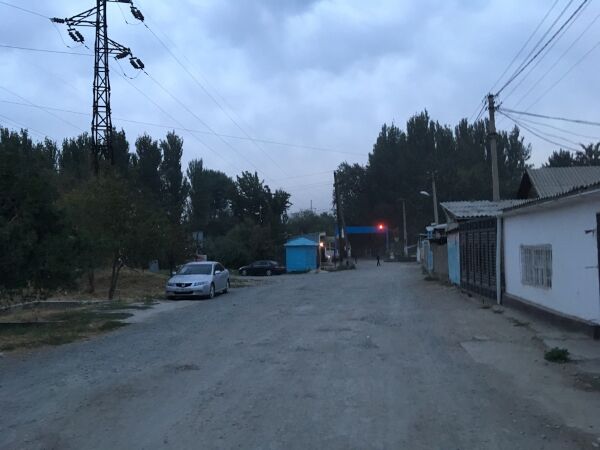
Illustration 1: Bishkek new settlement Ak-Tilek (source: author’s photograph, Philipp Lottholz)
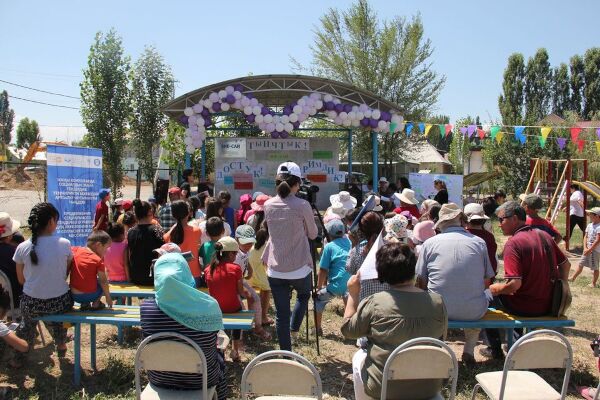
Illustration 2: Opening of a “communal space for communication” in Ene-Say 25
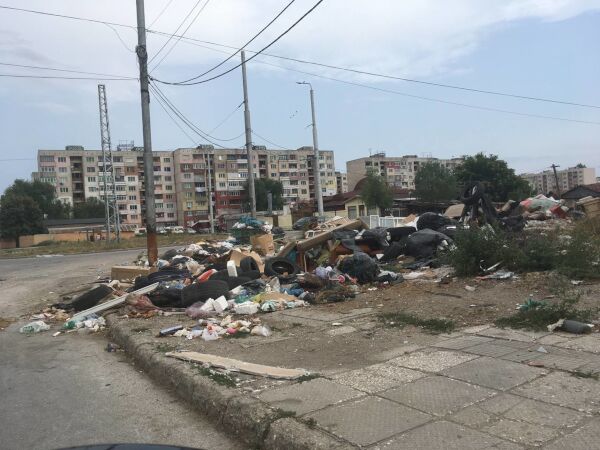
Illustrations 3: Stolipinovo district: Illegal rubbish dump (source: author’s photograph, Philipp Lottholz)
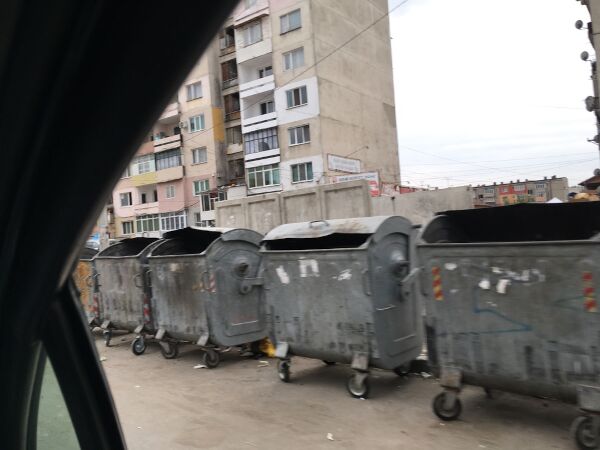
Illustrations 4: Stolipinovo district: Bins after collection(source: author’s photograph, Philipp Lottholz)
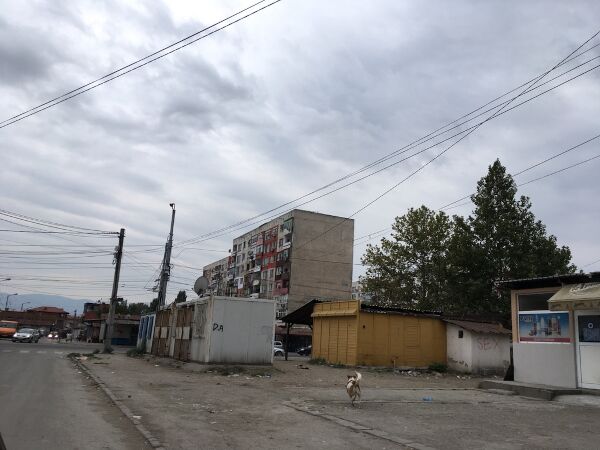
Illustrations 5: Stolipinovo district: Buildings in front of apartment blocks (source: author’s photograph, Philipp Lottholz)
ii) Social services, health care and education: In both contexts, many residents are refused access to welfare and health care, given that they do not have residential registrations and no health insurance plans. Limited legal knowledge and (in the Bulgarian case) language barriers complicate this. School education in Stolipinovo is facing quality issues, while it is completely lacking in Bishkek’s ‘new settlements,’ where the few existing schools have to accommodate up to five times more pupils than their capacity can manage and must, thus, work in multiple shifts; kindergartens and nurseries only exist in the urban center and are largely inaccessible or unaffordable.
The United Nations Population Fund project in Bishkek supplied some of the equipment lacking to health care structures alongside training in legal service obligations, mobilized ‘Public health committees’ to carry out preventive measures (e.g. measuring blood pressure), provided legal assistance for accessing health care and supported existing initiatives fighting for the creation of further schooling capacities. A municipality-run program in Plovdiv supported and extended a network of ‘health mediators’ and ‘education mediators,’ who help residents access services and improve communication and legal knowledge. This and other programs tried to foster minority youths’ ‘integration’ into a wider society through language training and cultural activities, which were said to be lacking and have led to an ‘encapsulated’ existence. Various community-based centers and organizations aim at strengthening youth education and care for people from disadvantaged backgrounds, but their reliance on European Union funding casts doubt on their long-term effectiveness.
iii) Public order and crime prevention: High rates of unemployment, poverty and sociocultural heterogeneity confound issues of petty crime, occasional larger conflicts along group/ethnic lines, and issues of domestic and gender-based violence in both contexts. Only formal institutions and structures deal with crime and deviance in Plovdiv, including the police, municipal-level public security bodies and various ‘Centers for Social Rehabilitation and Integration’ run by municipal and nongovernmental organization partnerships to prevent deviance among the disadvantaged or ‘at-risk’ (Bg.: riskovi) social groups. The present work, mostly carried out in nongovernmental organizations and foundations, focuses on the creation and capacitation of shelters and ‘centers for victims’ as well as support from the Centers for Social Rehabilitation and Integration for the children and youth affected. Petty and youth crime is almost exclusively dealt with by the police and municipal security services, with a few preventative measures carried out by nongovernmental organizations in schools. The local authorities, while absent in many regards, take a heavy-handed approach in regularly demolishing illegal buildings, such as garages and dwelling houses, which causes widespread indignation among community residents.
A number of community-level bodies work together with law enforcement in Bishkek to prevent and deal with domestic and low-level disputes/crimes. These include newly created initiative groups and formalized bodies, such as courts of elders or aksakals, alternative dispute resolution bodies operating according to Kyrgyz ‘customary law,’ ‘women councils’ or ‘Committees for the Prevention of Violence in Families.’ Current interventions aim at strengthening existing bodies’ work and creating new ones to deal more effectively with domestic and gender-based violence.
Politics of (and against) urban underdevelopment in the postsocialist-postcolonial conjuncture
The different forms of infrastructural and service deficits/failures and forms of self-organization to compensate for them point to important trends and implications for our theoretical discussion. Starting with the preconditions and their invocation in popular and powerholders’ narratives of underdevelopment justification and normalization; there is a striking difference in the generalized legitimization of the underdevelopment of new settlements across the two contexts. Narratives on the country’s peripheralization and socioeconomic disempowerment predominate in Bishkek, while in Plovdiv, infrastructural failures and the exclusion of some groups of urban development policies are justified with racializing discourses on otherness and undeservedness. In the case of Bishkek, one major factor (and partial justification narrative) of the infrastructural and service exclusion of new settlements is the national level of underdevelopment and economic dependency, which are conditioning a structural deficit and, hence, the inevitable exclusion of otherwise vital items from the state budget. This raises questions about the price of lobbying provisions to new settlements, as opinions on the competition between new settlements and ‘Bishkek proper’ indicate.26 The fact that some new settlements are well-connected and serviced shows that this is possible and largely dependent on negotiations with private sector service and infrastructure companies. Where infrastructure and services are not profitable, international organizations seem to be a preferred partner as they are ready to finance at least the most necessary – although often symbolic – provisions, a nexus which could be viewed through Rutazibwa’s conceptualization of development as reparation for underdevelopment in the global periphery wrought by the west.27 In contrast to that, the racism and cultural othering of minorities when explaining or justifying the disconnect of services and infrastructure in the Stolipinovo district of Plovdiv seemed deeply entrenched. Interviewees regarding all three subject areas portrayed the minority communities as ‘encapsulated’ (Bg. kapsulirani) and unable to integrate with the wider society, whether in linguistic terms, practices of waste disposal or adherence to legal procedures. The exclusion of these communities, thus, appears to be systemic, with little prospect of a way out, and, in light of few or no effective challenges, requires the nurturing of a new approach towards cultivating alternative thinking.
With regard to the second focal aspect of this contribution, that is, the various forms of self-organization and wider frameworks which are embedded in our research, we have identified a largely ‘corporatized’ model in Bulgaria under the obvious influence of the conditions that European Union and other international partners pose for funding support. This model involves nongovernmental organizations, various social and educational centers, and more socially grounded actors, such as ‘health’ or ‘education mediators’ that are operating on a fully official and salaried basis. It has the clear benefit that people working in these structures can devote more time and more easily be held accountable for their actions. On the other hand, the resident initiative ‘Residents of Stolipinovo’ was successful in mobilizing donations of food and basic necessities for people who had lost their livelihood during the COVID-19 pandemic. This initiative benefited from transnational solidarity and support from residents with higher incomes due to their labor migration to Western Europe. Yet, the dependence on labor migration of most of Stolipinovo’s population, who reside in the neighborhood for only limited periods of time, makes attempts to organize community life and maintain infrastructure more challenging. These issues are further complicated by tensions along socioeconomic lines – with better-off community members taking things ‘into their own hands’ and poorer ones unable to contribute equally – and between Roma and Turkish-origin groups that often exchange accusations and mutual stereotypes.
By contrast, there is a web of municipal, self-organized and more informal institutions and actors working on both community and neighborhood levels in Bishkek to compensate for the lack of and insufficient infrastructures and services. Such organizational networks can be defined as ‘socialized’ or ‘societal’ models, which benefit from voluntary work and spontaneous initiatives. As the analysis found, national-level nongovernmental organizations carrying out capacity-building and activation projects were successful in appointing new voluntary community leaders, initiative groups, committees and community centers as their partners, or reactivated already existing ones. That said, the wide range of infrastructure and service issues was only selectively mirrored in and addressed by these initiatives. Initiatives and groups working on less commonsense topics, such as domestic and gender-based violence, faced disagreement and even backlash when they tried to address cases, for example, of early marriage and domestic abuse. Furthermore, negotiation with local government and international organizations turned contentious when expectations beyond low-effort flagship projects (such as installing closed-circuit television or refurbishing sports pitches and children’s playgrounds) were addressed. Verbal altercations and tensions between the two sides pointed to the wider problem with the structural deficit of the municipality and state resources that, according to state representatives, precluded the fully fledged inclusion of new settlements’ infrastructural and service terms. Insights beyond the primary analytical focus revealed that efforts to improve living conditions on Bishkek’s urban margins have been long-standing and well-connected. The community-based nongovernmental organization Arysh, for instance, has been working with ‘self-help groups’ and initiative groups since 1997 and its exchange visits to and dialogue with community organizations in Bangalore, New Delhi and Agra in India since the year 2000 are a good example of the possibility of ‘transversal’ exchange and cooperation in trying to organize social and political movements.28
The picture of urban marginality and underdevelopment in Bishkek and Plovdiv presents, as we argue, a key site of the postsocialist-postcolonial conjuncture, where the coloniality of power produces palpable and lasting effects. Our contribution illustrates the “infrastructural activism” 29 and particularly forms of ‘repair citizenship’ that residents enact while helping to (re-)establish infrastructures and services, but also exhibits how their “incomplete”30 and abandoned status is being upheld by authorities’ uncooperative or even hostile stances. The othering and racializing logics underlying these positions present a contrast to the less explicitly racist urban regimes of the global South and North, and, thus, affirm the importance of looking at the postsocialist world in its own right.31 Furthermore, the insights into the transnational dimension of both the problem and the struggles and resistance against it point to the potential of linking and scaling up such movements. Perhaps more than these linkages, the parallels among novostroiki settlements within Central Asia bear even further potential for joint organization and exchange, while pan-European networks of Roma organizations present an important potential of drawing together ideas and resources for people in Stolipinovo and other Roma and Turkish-origin-dominated districts. While these potentials remain to be further explored, the contribution offered in this text is a perspective on how self-organization and mobilization emerge out of the conditions of a ‘bare’ and suppressed life in underdeveloped and systemically excluded urban communities as a key site of operation of the colonial matrix of power.
Notes:
1 Philipp Lottholz, Social Mobilisation in the Absence of Infrastructures and Services in Urban Margins: Toward “Societal Infrastructures”, in Voices on Central Asia (November 15, 2021), online version is available at https://voicesoncentralasia.org/social-mobilization-in-the-absence-of-infrastructure-and-services-on-the-urban-margins-toward-societal-infrastructures/.
2 Kiril Stanilov, Taking Stock of Post-Socialist Urban Development: A Recapitulation, in: Kiril Stanilov (ed.), The Post-Socialist City: Urban Form and Space Transformations in Central and Eastern Europe after Socialism. Dordrecht: Springer, 2007, pp. 3-17; Emil Nasritdinov / Bermet Zhumakadyr kyzy / Diana Asanalieva, Myths and Realities of Bishkek’s Novostroikas, in: Marlene Laruelle / John Engvall (eds.), Kyrgyzstan beyond “Democracy Island” and “Failing State”: Social and Political Changes in a Post-Soviet Society. Lanham, MD: Lexington Books, 2015, pp. 143-163.
3 Tsypylma Darieva / Wolfgang Kaschuba, Sights and Signs of Postsocialist Urbanism in Eurasia: An Introduction, in: Tsypylma Darieva / Wolfgang Kaschuba (eds.), Urban Spaces after Socialism. Ethnographies of Public Places in Eurasian Cities. Münster: Campus Verlag, 2011, here p. 9.
4 Stanilov, Taking Stock, pp. 3-4.
5 Miloš Jovanović, Bourgeois Worlds and Urban Nightmares: The Post-Ottoman Balkan City through the Lens of Milutin Uskoković’s Newcomers, in: Journal of Urban Cultural Studies 5 (2018), pp. 187-206.
6 For instance, Nick Megoran, Shared Space, Divided Space: Narrating Ethnic Histories of Osh, in: Environment and Planning A 45 (2013), pp. 892-907.
7 For instance, Stanilov, Taking Stock; Darieva / Kaschuba, Sights and Signs; and Tauri Tuvikene / Wladimir Sgibnev / Carola Neugebauer, Introduction: Linking Post-Socialist and Urban Infrastructures, in: Tauri Tuvikene et al. (eds.), Post-Socialist Urban Infrastructures. London: Routledge, 2019.
8 Stanilov, Taking Stock, p. 11; Tuvikene et al., Introduction, pp. 9 ff.
9 Stanilov, Taking Stock, p. 10.
10 Stanilov, Taking Stock, p. 12.
11 See Kemmer et al. and Stipic in this collection.
12 Tuvikene et al., Introduction, p. 3.
13 For instance, Liviu Chelcea / Gergő Pulay, Networked Infrastructures and the ‘Local’: Flows and Connectivity in a Postsocialist City, in: City 19 (2015), pp. 344-355.
14 Nikhil Anand / Akhil Gupta / Hannah Appel, Introduction: Temporality, Politics, and the Promise of Infrastructure, in: Nikhil Anand et al. (eds.), The Promise of Infrastructure. Durham: Duke University Press, 2018, here p. 3.
15 Anand et al., Introduction, p. 2.
16 Ruth Wilson Gilmore, Golden Gulag: Prisons, Surplus, Crisis, and Opposition in Globalizing California. Berkeley, CA: University of California Press, 2007, here p. 28; cited in Anand et al., Introduction.
17 Anand et al., Introduction , p. 4; Gilmore, Golden Gulag.
18 Anand et al., Introduction, p. 21.
19 Anand et al., Introduction , p. 11; Tuvikene et al., Introduction, p. 7.
20 Anand et al., Introduction , p. 3;
21 Chelcea / Pulay, Networked Infrastructures.
22 Manissa M. Maharawal, Infrastructural Activism: Google Bus Blockades, Affective Politics, and Environmental Gentrification in San Francisco, in: Antipode (2021).
23 Nasritdinov et al., Myths and Realities, p. 155.
24 United Nations Populations Fund (UNFPA) Evaluation of GPI Project “Addressing Social Disparity and Gender Inequality to Prevent Conflicts in New Settlements in Bishkek”, UNFPA Kyrgyzstan (2020), online version is available at https://mptf.undp.org/project/00108093 [scroll to “Project final reports”].
25 Facebook Page of UNFPA Kyrgyzstan, (June 25, 2019) online version is available at https://www.facebook.com/unfpa.kg/posts/2340580056009347?_tn_=-R
26 Nasritdinov et al., Myths and Realities, p. 147.
27 Olivia U. Rutazibwa, On Babies and Bathwater. Decolonizing International Development Studies, in: Sara De Jong / Rosalba Ocaza / Olivia U. Rutazibwa (eds.), Decolonization and Feminisms in Global Teaching and Learning. London: Routledge, 2019, Ch. 15.
28 Interview & informal conversation with representative of “Arysh,” Bishkek, September 11, 2019 and September 2, 2021.
29 Maharawal, Infrastructural Activism.
30 Chelcea / Pulay, Networked Infrastructures.
31 Tuvikene et al., Introduction.